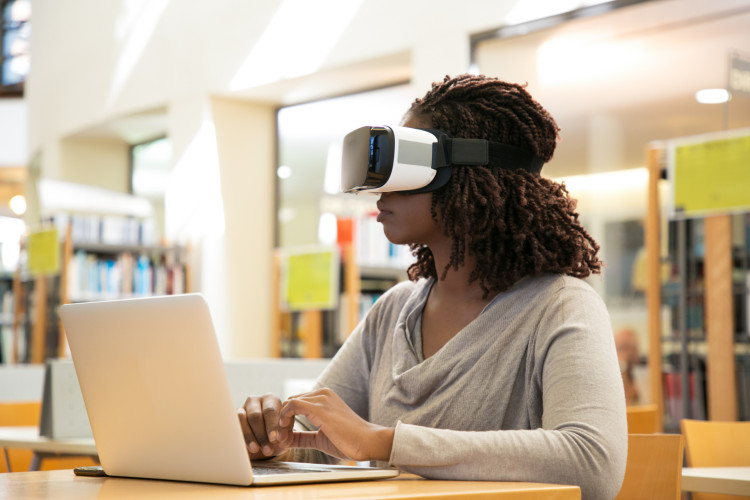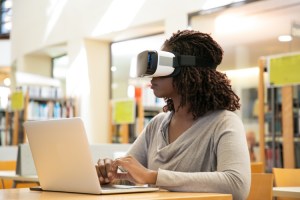The Need for Change in Higher Education


Dr. Mark Lombardi, President, Maryville University.
Students want to know whether going back to school now will set them up for long-term career success later. To this question, Dr. Mark Lombardi, president of Maryville University, has a forward-looking solution: empower students with data and services they can use both while in school and long after they’ve graduated.
“We’re talking about a network and an ecosystem where the learner owns their own data — educational and otherwise — and can use it throughout their career for continuous learning and skill development,” Dr. Lombardi explains in a speech for SXSW EDU 2022.
Career outcomes at Maryville University show that his student-centered approach is working: Under his leadership, 98% of Maryville’s graduates have secured jobs or enrolled in advanced education programs within six months of graduating.
Learn how Maryville University is putting student learning first through a strategic combination of data analytics, artificial intelligence (AI), and content management that empowers learners, employers, and educators to unlock higher education’s potential.
Higher Education Should Lead the Tech Revolution
Visionaries like Dr. Lombardi recognize that universities, once the epicenters of technological advancement, have too often become slow to empower students with cutting-edge digital tools.
“We created a culture that is completely resistant to innovation,” he says of higher education. “We’re almost comfortable in our own stasis. We actually pretend like we are detached observers of the digital revolution.” Hence the need for change in education.
Dr. Lombardi notes that fixable challenges have beleaguered higher education for decades:
- Research-obsessed environments that have failed to put learners first
- Information silos that discourage faculty experts from collaborating across disciplines
- Slow adoption of new technologies, resulting in disconnected campuses, poor communication infrastructure, and inadequate job preparation for students entering the workforce
- The “tyranny of the prerequisite,” which blocks students from taking useful or interesting courses until they take a long sequence of prerequisites
These failures of higher education have resulted in the untapped potential for learner-focused education, Dr. Lombardi says. But there’s hope.
Consider three areas Maryville University is exploring to make better use of technology and to empower collaboration among learners, educators, and future employers.
1. Harnessing Adaptive Learning Software
Adaptive learning software is just what it sounds like: software that adapts to how a student learns. It is driven by technology that allows students to progress at their own pace, based on how well they grasp various concepts. This is a big departure from the way teaching has been done in the past, ushering in a change in education delivery.
Advances in AI are powering a more efficient and effective learning experience. Features of AI-driven adaptive learning software include:
- Advanced, real-time adaptations based on learner behavior and performance
- Data-driven, personalized feedback
- Evidence-based knowledge reinforcement activities to support remediation
Teaching with adaptive software is not linear like textbook teaching in a traditional classroom. Instead of all students following the curriculum at a consistent pace, AI empowers individualized learning experiences specific to each student’s abilities and interests.
Looking to the future, Dr. Lombardi envisions universities using AI tools to create individualized learner profiles that bridge the gap between students and their future employers.
“With AI, we can create a common language between education and employers, so employers don’t have to decipher what this degree means and whether this graduate has [the necessary] capabilities … We can take the learner data and we can empower them with choices, actions, and outcomes.”
2. Leveraging Learning Management Systems
Learning management systems (LMSs) are software applications that enable students to learn online. E-learning became more popular during the coronavirus pandemic as schools transitioned from in-person to online and hybrid learning models.
Today, LMS can support an array of online activities, both synchronously and asynchronously, including:
- Lesson creation
- Content delivery, via readings, lecture videos, and online activities
- Class discussion, via instant messaging and message board posting
- Project collaboration
- Progress tracking
- Grade reporting and feedback communication
- Administrative support, including documentation, reporting, and course management
As learning models change, faculty can help design the next generation of technology to better meet their needs and, more importantly, the needs of their students. Globally, the total number of LMS users is estimated at 73.8 million, according to the chief data scientist and head of content at Research.com. The same source reports that 90% of students prefer some form of online learning to traditional learning methods.
At Maryville University, students use the LMS Canvas to connect with professors, discuss course material with classmates, and stay up to date with class assignments.
3. Integrating Subscription-Based Learning
Facilitating continuous career development and lifelong learning is a top priority for students pursuing higher education today. In a poll of 5,000 employees in 2022, 40% said they worried they would need to learn new skills in the near future due to technological changes in the workplace, such as the widespread adoption of AI and automation, according to SHRM.
Maryville University is preparing new ways to support students returning to school to gain new skills for the employment opportunities of the future. Leaders like Dr. Lombardi see this change in educational needs — from traditional degrees to certificates, competencies, and other continuing education programs — as an opportunity to support students through a subscription-based learning model.
“How it’s going to operate is, you’re not going to pay 30, 50, 70,000 a year” for a single degree program that may teach skills that quickly become outdated in a rapidly changing workforce, Dr. Lombardi says. Instead, students will be able to enroll in and pay for classes via a “subscription model, like Netflix or your cellphone bill — and you’ll have access to it for a lifetime.”
With subscription-based learning, students can chart their own educational pathway — picking up the skills and competencies they need to lead in technology, business, healthcare, or another field. “It’s an access and opportunity revolution,” Dr. Lombardi says. “It’s mobile, and it’s flexible, and it’s here.”

Change Your Life Through Education
Changes in student needs should inspire changes in education. At Maryville University, students come first. Our innovative programs offer unique flexibility for students pursuing career advancement through higher education.
Professionals with a passion for improving the higher education market and other industries through technology can learn more about Maryville’s cutting-edge online computer science programs, which include advanced degrees in fields such as artificial intelligence, data analytics, and data science. Maryville also offers a Doctor of Education in Higher Education Leadership program for those interested in leading educational institutions through innovative change. Explore Maryville’s wide range of online bachelor’s, master’s, doctoral, and certificate programs today.
Recommended Reading
Dr. Lombardi at SXSW Edu 2022: Access and Opportunity in Higher Education
Maryville’s Approach to Technology and Higher Education in the Digital Age
Emerging Leaders in Higher Education
Sources:
Class Central, Massive List of MOOC Platforms Around the World in 2023
ELearning Industry, “AI-Powered LMS and Standard LMS? Which One to Choose?”
History.com, “George Washington Carver”
Maryville University, Online Interactive Learning Tools
Research.com, “51 LMS Statistics: 2023 Data, Trends & Predictions”
Research and Markets, “Learning Management System (LMS) Global Market Report 2022”
SHRM, “Employees Want Additional Opportunities for Career, Skills Development”

